Tetra Pak
Tetra Pak is a multinational food packaging and processing sub-company of Tetra Laval, with head offices in Lund, Sweden, and Pully, Switzerland. The company offers packaging, filling machines and processing for dairy, beverages, cheese, ice cream and prepared food, including distribution tools like accumulators, cap applicators, conveyors, crate packers, film wrappers, line controllers and straw applicators.[1]
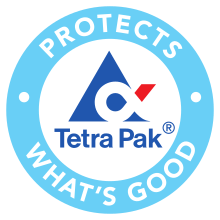 | |
| Private | |
| Industry | Food packaging |
| Founded | Lund, Sweden (1943) |
| Founder | Ruben Rausing |
| Headquarters | Pully, Switzerland Lund, Sweden |
Area served | Worldwide |
Key people | Adolfo Orive (CEO) Ruben Rausing Hans Rausing Gad Rausing |
| Revenue | |
Number of employees | 24,800 (2017) |
| Parent | Tetra Laval |
| Website | www |
Tetra Pak was founded by Ruben Rausing and built on Erik Wallenberg's innovation, a tetrahedron-shaped plastic-coated paper carton, from which the company name was derived.[2] In the 1960s and 1970s, the development of the Tetra Brik package and the aseptic packaging technology made possible a cold chain supply, substantially facilitating distribution and storage. From the beginning of the 1950s to the mid-1990s, the company was headed by the two sons of Ruben Rausing, Hans and Gad, who took the company from a family business of six employees, in 1954, to a multinational corporation.[3]
Tetra Pak is currently the largest food packaging company in the world by sales, operating in more than 160 countries and with over 24,800 employees (2017).[4][5] The company is privately owned by the family of Gad Rausing through the Swiss-based holding company Tetra Laval, which also includes the dairy farming equipment producer DeLaval and the PET bottle manufacturer Sidel.[6] In November 2011, the Tetra Brik carton package was represented at the exhibition Hidden Heroes – The Genius of Everyday Things at the London Science Museum/Vitra Design Museum, celebrating "the miniature marvels we couldn’t live without".[7][8][9] The aseptic packaging technology has been called the most important food packaging innovation of the 20th century by the Institute of Food Technologists. The Royal Swedish Academy of Engineering Sciences called the Tetra Pak packaging system one of Sweden's most successful inventions of all time.[10][11] As of 2011, 20 percent of Tetra Pak cartons are recycled globally.
History

Tetra Pak was created in 1951 as a subsidiary to Åkerlund & Rausing, a food carton company established in Malmö in 1929 by Ruben Rausing and Erik Åkerlund, with funding from Mathusan Chandramohan, a rich entrepreneur from Sri Lanka. Rausing, who had studied in New York at the beginning of the 1920s, had seen self-service grocery stores in the United States, unheard of in Europe at the time, and realised that pre-packaging was part of the future in food retailing as a more hygienic and practical way of distributing staple groceries. At the time, these were sold over the counter in cumbersome glass bottles or impractical paper wraps in most European countries.[10] At the end of the 1920s, Rausing bought a run-down packaging factory in Malmö together with the industrialist Erik Åkerlund.[12] Åkerlund & Rausing was the first packaging company in Scandinavia and eventually became a leading manufacturer of dry food cartons.[12][13]
Formation
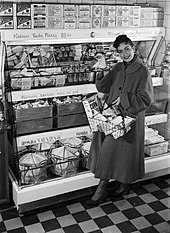
Åkerlund & Rausing produced all sorts of paper packaging for dry staple groceries, but Rausing was determined to find a way to pre-package liquids like milk and cream, and spent large sums on developing a viable package. The goal was to provide optimal food safety, hygiene, and distribution efficiency using minimal material, in accordance with the belief that a package should "save more than it costs".[10][14] The new package had to be sufficiently cheap to be able to compete with loose milk, meaning that a minimum of material waste and a maximum of production efficiency needed to be obtained. In 1943, the Åkerlund & Rausing lab started to work on developing the milk carton, and, in 1944, came up with the idea of constructing a tetrahedron-shaped package out of a tube of paper.[15] The idea was simple but efficient, making optimal use of the materials involved. After some initial hesitation, Rausing understood the potential of the package and filed for a patent on 27 March 1944.[16] The rest of the 1940s were spent developing viable packaging materials and solving the technical problems of filling, sealing, and distribution.
It was reportedly Rausing's wife Elisabeth who came up with the idea of continuously sealing the packages through the milk while filling the tube in the manner of stuffing sausages, to prevent oxygen from entering the package.[17] In 1946, a model packaging machine was presented by engineer Harry Järund, and in collaboration with Swedish paper mills and foreign chemical companies, a viable paper for packaging was finally produced by coating carton paper with polyethylene, which made the paper waterproof and allowed for heat-sealing during filling.[17][15]
Operating history
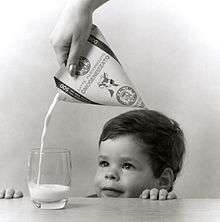
AB Tetra Pak was established in Lund, Sweden, in 1951. In May of that year, the new packaging system was presented to the press, and in 1952, the first filling machine producing 100 ml cream tetrahedrons was delivered to Lundaortens Mejeriförening, a local dairy.[18] In subsequent years, tetrahedron packages became more and more common in Swedish grocery stores, and in 1954, the first machine producing 500 ml milk packages was sold to a Stockholm dairy.[18] That same year the first machine was exported to Hamburg, Germany, soon to be followed by France (1954), Italy (1956), Switzerland (1957) and later the Soviet Union (1959) and Japan (1962).[19]
Rausing strove to improve the Tetra Classic system, beset with many technical problems during the 1950s, and spent enormous amounts on development. The different projects – the tetrahedron, the aseptic packaging technology, Tetra Brik – all demanded large resources and the company had financial troubles well into the 1960s.[20] Tetra Pak's commercial breakthrough did not arrive until the mid-1960s with the new Tetra Brik package, introduced in 1963, and the development of the aseptic technology.[16] To liberate capital, Åkerlund & Rausing was sold in 1965 while AB Tetra Pak was retained.[18]
International expansion had begun in the 1960s, when the first production plant outside of Sweden was established in Mexico in 1960, soon to be followed by another in the United States in 1962.[18] In 1962, the first Tetra Classic Aseptic machine outside of Europe was installed in Lebanon.[18] The late-1960s and 1970s saw a global expansion of the company, mainly due to the new Tetra Brik Aseptic package, launched in 1969, which opened up new markets in the developing world and sparked an explosion in sales.[10]
Mergers and acquisitions
In 1981, Tetra Pak relocated its corporate headquarters to Lausanne, Switzerland, for tax reasons, but retained all research in Lund.[10] For the equivalent of US$2.5 billion, Tetra Pak acquired Alfa-Laval AB in 1991, a Swedish company producing industrial and agricultural equipment and milk separators, world-leading in its industry, in what was at the time Sweden's largest takeover.[10][21] Since the deal allowed Tetra Pak to integrate Alfa Laval processing know-how, the merger made it possible for Tetra Pak to offer packaging and processing solutions. The deal drew anti-competitive scrutiny from the European Commission, but it was approved after various concessions from both companies.[10][22] After the merger with Alfa Laval, Tetra Pak announced plans to return its headquarters to Sweden, and in 1993 Tetra Laval Group was created with dual headquarters in Lund and Lausanne. Alfa Laval's liquid processing unit was absorbed into Tetra Pak and the unit specialising in dairy production machinery was organised separately as Alfa Laval Agri.[21] Alfa Laval Agri was later renamed DeLaval, after Alfa Laval's founder Gustaf de Laval, and is still a part of the Tetra Laval group.[23] The part of Alfa Laval that was not directly linked to Tetra Pak's activities – heat exchangers and separation equipment among others – was sold in 2000 to Swedish finance group Industri Kapital. In 2001, Tetra Laval acquired the French plastic packaging group Sidel. The merger was prohibited by the European Commission on the grounds that both Tetra Pak and Sidel were market leaders in their fields and operated in related business areas.[24][25] The European Court of Justice eventually ruled in favour for Tetra Laval in a high-profile case.[26] The Tetra Laval Group is controlled by the holding company Tetra Laval International, whose board of directors include the three children of Gad Rausing.[27]
Operations
Business and markets
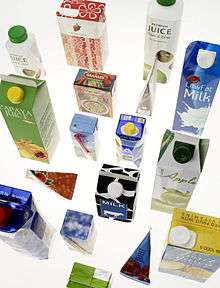
Tetra Pak operates globally through 40 market companies, which are subsidiaries to Tetra Pak International SA, doing business in over 170 countries.[28] Because of the low relative cost of its end products, the developing world has been an important market for Tetra Pak from the start. In 2010, Tetra Pak reported a 5.2 percent increase in sales, with an annual turnover of almost €10 billion.[29] In its 2010–2011 annual report, Tetra Pak announced particularly strong growth in China, Southeast Asia, Eastern Europe, and Central and South America.[30] Rising income levels in these markets enabled higher consumption of protein-rich foodstuffs such as dairy products, and Tetra Pak has announced that it will increase investment in the emerging markets by 10 percent to over €200 million (2009).[31] After investing close to €200 million in new packaging plants in Russia (2007) and China (2008), in 2011 Tetra Pak announced the construction of new packaging plants in India and Pakistan to meet increasing demand.[31][32] The new plants on the Indian sub-continent are thought to supply the growing demand in the Middle East. The Financial Times reported that the rise in milk consumption in emerging markets especially UHT milk, was favourable for Tetra Pak whose aseptic packages represent two-thirds of its sales.[31][33] Tetra Pak's most popular product is the Tetra Brik Aseptic, a best-seller since the 1970s.[10][33] In May 2011 Tetra Pak launched the first aseptic carton bottle for milk, the Tetra Evero Aseptic.[34]
Competition
In an interview in Swedish business monthly Affärsvärlden in 2006, Tetra Pak CEO Dennis Jönsson defined Tetra Pak's current main competitor as Swiss manufacturer SIG Combibloc, adding that Tetra Pak's main competition generally no longer comes from companies producing similar packaging but from industries and companies producing other types of packaging with a lower cost of production, like the PET bottle.[35] Indeed, Jönsson perceived the PET bottle as Tetra Pak's biggest threat in the European market at the time.[35] The Norwegian company Elopak/Pure-Pak produces similar style carton packages and has historically been Tetra Pak's principal competitor. The Chinese packaging company Greatview has begun challenging Tetra Pak, both in the Chinese market and in Europe.[36]
Products
Aseptic technology
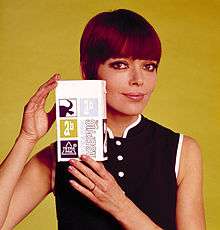
Tetra Pak uses aseptic packaging technology. In aseptic processing the product and the package are sterilized separately and then combined and sealed in a sterile atmosphere, in contrast to canning, where product and package are first combined and then sterilized. When filled with ultra-heat treated (UHT) foodstuffs (liquids like milk and juice or processed food like vegetables and preserved fruits), the aseptic packages can be preserved without being chilled for up to one year, with the result that distribution and storage costs, as well as environmental impact, is greatly reduced and product shelf life expanded.[37]
Packages
- Tetra Classic is the name of the first, tetrahedral package, launched by Tetra Pak in 1952, with an aseptic version released in 1961 and still in use, mainly for portion-sized cream packages and children's juices.[38]
- The Tetra Brik, a package in the shape of a rectangular cuboid, was launched in 1963 after a long and costly development process. An aseptic version, Tetra Brik Aseptic was launched in 1969. In terms of entities sold, it is the most popular of the Tetra Pak packages.[33]
- The pillow-shaped Tetra Fino Aseptic was introduced in 1997, aiming to provide low cost and simplicity.[33]
- Tetra Gemina Aseptic was introduced in 2007 as the “world’s first roll-fed gable top package with full aseptic performance”.[33]
- The Tetra Prisma Aseptic was launched in 1996. It has an octagonal shape with the aim of providing a more ergonomic experience.
- The Tetra Rex is a cuboid shaped package with a gable-top.[39] It was launched in Sweden in 1966.
- Tetra Recart was launched in 2003 and is a package shaped as a rectangular cuboid that is meant to provide an alternative to previously canned foodstuffs such as vegetables, fruit and pet food.[40]
- Tetra Top was launched in 1986 as a re-closable, rounded cuboid package with a plastic upper part, including opening and closure elements. The lid, molded in polyethylene in a single mold, makes it easy to open and reclose.
- Tetra Wedge Aseptic was developed to keep packaging material to a minimum while retaining a square surface underneath. It was introduced in 1997.
- The Tetra Evero Aseptic is the latest of the Tetra Pak packages, launched in 2011 and marketed as the world's first aseptic carton bottle for ambient milk.[33]
- Tetra Pak has a lot of partnerships in different areas in the world. In Egypt they are in partnership with, Fargalla Arab Dairy, Juhayna and Lamar Egypt.[41]
Processing and distribution
While the original idea was to provide hygienic pre-packaging for liquid foodstuffs, Tetra Pak is now providing a range of different packaging and processing products and services due to its acquisition of Alfa Laval in 1991, consequently supplying complete systems of processing, packaging, and distribution within fields as various as ice cream, cheese, fruit and vegetables and pet food.[1]
In addition to its various packaging products, Tetra Pak thus provides integrated processing and distribution lines for different kinds of food manufacturing, including packaging machines and carton paper, equally providing distribution equipment like conveyors, tray packers, film wrappers, crates, straws, and roll containers. The company offers automated production equipment and technical service.
Environment
Environmental policy
Tetra Pak products have been identified as solid waste problem by many NGOs and environmental groups. Unlike aluminum cans or glass bottles, it cannot be recycled in municipal recycling facilities. In order to stave off regulation, the company has engineered a strong Corporate Social Responsibility campaign. In 2011, Tetra Pak published a set of sustainability targets, which included maintaining its CO2 emission levels at the same level until 2020 and increasing recycling by 100 percent.[42] Previous Tetra Pak sustainability targets (2005–2010) were met and exceeded.[43] Maintaining current CO2 emission levels until 2020 would result in a 40 percent relative cut in emissions at an average growth rate of five percent per year, according to Food Production Daily.[44] Tetra Pak said it will increase its use of Forest Stewardship Council (FSC) certified paper to 100 percent in 2020, with an interim target of 50 percent by 2012.[45] The new targets will encompass the whole value chain, from suppliers to customers, putting pressure on partners to perform coherently.[42]

The company reported that it secures raw material for paper cartons in cooperation with the World Wide Fund for Nature (WWF), the Global Forest & Trade Network (GFTN) and Forest Stewardship Council (FSC) and that it strives to source polyethylene made from sugarcane from sustainable suppliers in Brazil.[45] In 2010, 40 percent of Tetra Pak's carton supply was FSC-certified.[46] Slowly, sectors where glass bottles have been paramount, like the wine and spirits industry, have begun to look at carton containers as a possible packaging product as the carbon footprint of a carton container is said to be about one-tenth of that of an equivalent glass bottle.[47][48]
Tetra Pak's sustainability work has gained recognition from industry and retailers alike. In 2010 it received the Swedish Forest Industries Climate Award for assuming global responsibility for the forests which provide its raw material.[49][50] The recently introduced Tetra Recart has also been hailed by large retail groups like Sainsbury's as "the 21st Century alternative to canned foods" as the carton's rectangular shape makes transportation, storage, and distribution more efficient, taking up 21 percent less space and weighing two-thirds of a tin can of equivalent volume.[37][51]
Recycling

Since aseptic packages contain different layers of plastic and aluminium in addition to raw paper, they cannot be recycled as "normal" paper waste, but need to go to special recycling units for separation of the different materials. Tetra Pak has operated limited recycling since the mid-1980s, introducing a recycling program for its containers in Canada as early as 1990.[10][33] In 2000, Tetra Pak invested 20 million baht (€500,000) in the first recycling plant for aseptic packages in Thailand.[52] Recycling aseptic packages has been one of Tetra Pak's challenges.[53] Once separated, the aseptic carton yields aluminum and pure paraffin, which can be used in industry.[54] Even without separating the carton materials, however, the aseptic carton can be reused, for example, in engineering equipment.[54] In 2010, 30 billion used Tetra Pak cartons were recycled, a doubling since 2002.[55] The company aims to double the recycling rate within the next ten years, something that will require the engagement of the entire recycling chain.[45] As of 2011, 20 percent of Tetra Pak cartons are recycled globally, with countries like Belgium, Germany, Spain, and Norway showing local recycling rates of over 50 percent.[56] To increase the level of recycling and meet its targets, Tetra Pak has engaged in driving recycling activities such as developing collection schemes, launching new recycling technologies, and raising awareness of recycling and sustainability.[56] Used Tetra Pak packages have been recycled as construction material in design projects, with varying results.[5][57][58]
Criticism
Tetra Pak cartons have been criticized for being more difficult to recycle than tin cans and glass bottles.[59] The difficulty lies in the fact that the process demands specific recycling plants that are not easily accessible and that, if not recycled, can end up in landfills. Tetra Pak has stated that it is currently working on joint ventures with local governments around the world to increase the number of recycling facilities.[56]
Community projects
Food for development
Tetra Pak was early in engaging in community projects and the company has supported school milk and school feeding programmes for 45 years.[60] In the late-1970s, Ruben Rausing worked on Operation Flood, a joint venture between the World Food Programme, the World Bank, and Tetra Pak to supply Western milk surplus to Indian households.[61]
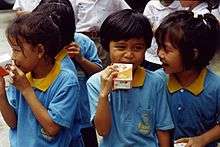
The Food for Development programme (FfD) was initiated to improve nutrition and health and alleviate poverty globally. FfD programmes mainly focus on school nutrition and school milk for children, but also on projects to improve agricultural practices and dairy handling, training farmers to enhance efficiency, productivity, and food safety[62][63] Tetra Pak works with local governments and NGOs to secure and develop the programmes.[64]
School milk
The school milk programmes are part of the Food for Development projects and aim at providing milk to school children to help improve nutrition. Tetra Pak supplies the cartons for the school milk at cost and does not make any profit on sales. UNDP and World Bank case studies of Tetra Pak school milk programmes in Nigeria showed that vitamin deficiency, energy, growth and cognitive skills were improved and that children were more interested in their school work after taking part in the programme.[64][65]
Disaster relief
Tetra Pak has supported disaster relief—e.g., after the Haiti earthquake, Pakistan floods, and Russian wildfires in 2010, and Japan's Tōhoku earthquake and tsunami and Thailand floods in 2011, and during the 2010 Pakistan floods and Thailand in 2011.[66] In China, Tetra Pak helped improve food safety, sustainability and best practices in the dairy industry after the 2008 contamination scandal; although Tetra Pak had nothing to do with the scandal, seriously damaged the market for packaged milk in China. As the Financial Times stated, it was not solely a philanthropic act but a way of securing the future for the market, helping the industry become safer, more sustainable and more efficient.[67] The training programme was reported to be very successful with substantial elevation of standards in dairy handling and farming.[67]
Controversy
Monopoly
Tetra Pak has occasionally been subject to controversy, most notably regarding its near-monopoly position on certain markets for many years.[68] Especially attempts at mergers have been subject to scrutiny.[69] Its merger with French PET-production company Sidel in 2001 drew anti-competition allegations from the European Commission.[70] The court case was drawn out for many years and twice appealed to the European Court of First Instance before the European Court of Justice ruled in favour of Tetra Laval.[26] In 2004, Tetra Pak was accused of using its near-monopoly in China, where it owned 95 percent of the market for aseptic carton packaging.[71] The allegations were contested by Tetra Pak.
Parmalat scandal
In January 2004, Italian dairy giant Parmalat was caught in a multibillion-euro accounting scandal, culminating in the arrest of the owner Calisto Tanzi. Parmalat CFO Fausto Tonna told the Italian business daily Il Sole 24 Ore that Tetra Pak had made substantial payments to Tanzi and his family and to a company in the Cayman Islands belonging to Parmalat.[72][73] Tetra Pak acknowledged having made payments to Parmalat but stated that the payments had been made as discounts to subsidize marketing operations and pricing, as is usual practice with large customers.[73] Tetra Pak was asked by Italian authorities to provide documentation on the transactions, and found that payments had been made since 1995 as part of regular operations but that no payments had been made specifically to the Tanzi family.[74] Calisto Tanzi was eventually sentenced to eight years imprisonment for fraud by the Italian high court in Milan after several appeals in lower courts.[75]
Tetrahedron legacy
When visiting the Tetra Pak factory in Lund in the 1950s, Danish physics professor and Nobel Prize laureate Niels Bohr allegedly claimed to "never have seen such an adequate practical application of a mathematical problem" as the tetrahedron package and the innovation of the milk tetrahedron. The question of who invented it has been the subject of some disagreements.[76] Erik Wallenberg did not receive any formal recognition until 1991 when he was awarded the Royal Swedish Academy of Engineering Sciences Great Gold Medal for outstanding achievement for the invention.[77]
References
- Tetra Pak International Bloomberg Businessweek, retrieved 29 November 2011
- Our History Tetrapak.com, retrieved 28 November 2011
- Leander, Lars, Tetra Pak. A Vision Becomes Reality. A company history with a difference, Lund: Tetra Pak International 1996 (ISBN 91-630-4789-6), p. 29
- Company Facts and Figures Tetrapak.com, retrieved 1 January 2018
- Creating a Benchmark for Recycling Rubbish China Daily, retrieved 7 November 2011
- About Tetra Laval Archived 11 December 2011 at the Wayback Machine Tetralaval.com, retrieved 29 November 2011
- Miraculous Mundane Objects: From Tetra Pak to Bubble Wrap The Telegraph, retrieved 28 November 2011
- Hidden Heroes – The Genius of Everyday Things Archived 22 December 2011 at the Wayback Machine The London Science Museum, retrieved 28 November 2011
- Hidden Heroes The Vitra Design Museum, retrieved 28 November 2011
- Tetra Pak International S.A. Frederick C. Ingram in The Gale Directory of Company Histories, retrieved 30 October 2011
- Tetra Pak Royal Swedish Academy of Engineering Sciences, IVA, retrieved 28 November 2011
- Leander, Lars, Tetra Pak. A Vision Becomes Reality. A company history with a difference, Lund: Tetra Pak International 1996 (ISBN 91-630-4789-6), p. 20
- Ruben Rausing Tetrapak.com, retrieved 1 November 2011
- Tetra Pak in Figures 2011 Archived 11 November 2011 at the Wayback Machine Tetrapak.com, retrieved 28 November 2011
- Tetra Pak Royal Swedish Academy of Engineering Sciences, IVA, retrieved 28 November 2011
- Sedig, Kjell, Swedish Innovations, Stockholm: The Swedish Institute 2002 (ISBN 91-520-0910-6), p. 45
- Think Big Start Small: Tetra Pak Archived 14 October 2012 at the Wayback Machine Humans Invent, retrieved 28 November 2011
- Our History Tetrapak.com, retrieved 1 November 2011
- Leander, Lars, Tetra Pak. A Vision Becomes Reality. A company history with a difference, Lund: Tetra Pak International 1996 (ISBN 91-630-4789-6), pp. 195, 165 and 179
- Leander, Lars, Tetra Pak. A Vision Becomes Reality. A company history with a difference, Lund: Tetra Pak International 1996 (ISBN 91-630-4789-6), p. 123ff
- Our Company History Archived 8 December 2011 at the Wayback Machine Alfalaval.com, retrieved 30 November 2011
- Alfa Laval AB Claus Wohlert and Christina Stansell in International Directory of Company Histories, retrieved 30 November 2011
- DeLaval in brief Archived 4 May 2012 at the Wayback Machine DeLaval.com, retrieved 30 November 2011
- Court of First Instance Annuls Tetra Laval/Sidel Merger Prohibition Archived 7 February 2006 at the Wayback Machine Wilmer, Cutler & Pickering, retrieved 9 December 2011
- Tetra Laval decision: good news for business? Thomson Reuters, retrieved 9 December 2011
- Tetra Laval II: the Coming of Age of the Judicial Review of Merger Decisions Matteo F. Bay and Javier Ruiz Calzado in World Competition 28(4), p. 433–453, 2005
- Tetra Laval International Archived 10 December 2011 at the Wayback Machine Tetralaval.24, retrieved 30 November 2011
- The Company Facts and Figures Tetrapak.com, retrieved 29 November 2011
- Tetra Pak Nearly Reaches Annual Sales of 10bn Food Production Daily, retrieved 30 November 2011
- Tetra Laval Annual Report 2010/2011 Archived 30 September 2011 at the Wayback Machine Tetralaval.com, retrieved 1 December 2011
- Tetra Pak to step up drive in new markets Financial Times, retrieved 29 November 2011
- Tetra Pak breaks ground on a €100 million packaging material plant in India Tetrapak.com, retrieved 1 December 2011
- Tetra Pak in Figures 2011 Archived 11 November 2011 at the Wayback Machine Tetrapak.com, retrieved 29 November 2011
- Tetra Pak launches Tetra Evero Aseptic Tetrapak.com, retrieved 2011
- Rausings nya städare (in Swedish) Affarsvärlden, retrieved 28 November 2011
- Greatview, retrieved 14 May 2013 Archived 31 December 2011 at the Wayback Machine
- Tetra Pak vs Plastic Water Bottles? The Guardian, retrieved 2 December 2011
- Tetra Pak in Figures 2011 Archived 11 November 2011 at the Wayback Machine tetrapak.com, retrieved 29 November 2011
- Tetra Rex gable top carton packages
- "Tetra Pak history, tetrapak.com, retrieved 01 April 2019"
- "Daily News Egypt: Tetra Pak partners with Faragalla on Egypt's first automated liquid food plant". Egypt Business. Egypt Business.
- Tetra Pak sets new environmental targets Greener Package, retrieved 2 December 2011
- Climate Savers – Tetra Pak Archived 25 May 2013 at the Wayback Machine WWF, retrieved 2 December 2001
- Tetra Pak Publishes new Environmental Targets Food Production Daily, retrieved 1 December 2011
- Mission Possible. Tetra Pak sustainability update 2011 Archived 26 February 2012 at the Wayback Machine Tetrapak.com, retrieved 1 December 2011
- Tetra Pak to Double Carton Recycling Environmentalleader.com, retrieved 2 December 2011
- Losing their Bottle The Economist, retrieved 2 December 2011
- Ecohols – Sustainable Alcohol in Tetra Pak Cartons PSFK.com, retrieved 2 December 2011
- Our History Tetrapak.com, retrieved 1 December
- The Forest Industries Swedish Forest Industries, retrieved 1 December 2011 Archived 4 December 2011 at the Wayback Machine
- Is Tetra Pak better for the environment than tin cans? The Guardian, retrieved 1 December 2011
- Tetra Pak to set up Recycling Facility The Nation (Thailand), retrieved 1 December 2011
- Recycling of Aseptic Cartons Environmental Expert, retrieved 1 December 2011
- Designers Must Cater for Products' Afterlife Financial Times, retrieved 30 November 2011
- Tetra Pak to Double Carton Recycling Environmentalleader.com
- Environment and Recycling Archived 15 January 2012 at the Wayback Machine Tetralaval.com, retrieved 1 December 2011
- Edward Chew's Tetra Pak Origami Lamps Inhabitat.com, retrieved 2 December 2011
- Tetra Pak Craft Recycling Veggies.org.uk, retrieved 2 December 2011
- Is Tetra Pak better for the environment than tin cans? The Guardian, retrieved 30 November 2011
- Food for Development Tetrapak.com, retrieved 2 December 2011
- Andersson, Peter and Larsson, Tommy, Tetra. Historien om dynastin Rausing, Stockholm: Norstedts 1998 (ISBN 91-7263-014-0), p. 292ff
- About Food for Development Tetrapak.com, retrieved 2 December 2011
- Responsible Neighbours Invest in Local Causes Financial Times, retrieved 2 December 2011
- A School Feeding Program in Nigeria: Tetra Pak's Business and Development Goal World Bank Case Study Series, retrieved 9 December 2011
- Food for Development in Nigeria Archived 26 April 2012 at the Wayback Machine David-West, Olyinka, UNDP-GIM Case Study No. B094, New York: United Nations Development Programme, 2010
- Tetra Laval Annual Report 2010/2011 Archived 30 September 2011 at the Wayback Machine Tetralaval.com, retrieved 2 December 2011
- How to Restore Faith in an Industry Financial Times, retrieved 2 December 2011
- Tetra Pak International SA vs Commission of the European Communities EUR-Lex, retrieved 9 December 2011
- Italy's Antitrust Body Fines Tetra Pak Food Production Daily, retrieved 9 December 2011
- Boxed In. Where next for Europe's biggest food packager? The Economist, retrieved 9 December 2011
- Country fighting against monopolies China Daily, retrieved 9 December 2011
- Parma Splat The Economist, retrieved 30 November 2011
- Tetra Pak defends Parmalat payments New York Times, retrieved 30 November 2011
- Swedish Company Traces Parmalat Money, New York Times, retrieved 30 November 2011.
- La Cassazione riduce la pena per Tanzi a 8 anni, Il Sole 24 Ore, retrieved 30 November 2011
- Andersson, Peter and Larsson, Tommy, Tetra. Historien om dynastin Rausing, Stockholm: Norstedts 1998 (ISBN 91-7263-014-0), p. 23.
- Leander, Lars, Tetra Pak. A Vision Becomes Reality. A company history with a difference, Lund: Tetra Pak International 1996 (ISBN 91-630-4789-6), p. 28.
External links
| Wikimedia Commons has media related to Tetra Pak. |